Themed collection SDG14: Life Below Water – Marine Litter (Plastics and Pollution)

Microplastics in ecosystems: their implications and mitigation pathways
Microplastic (MP) pollution is an emerging threat to terrestrial and aquatic ecosystems.
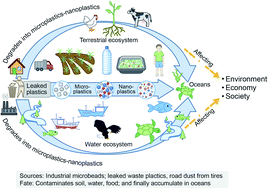
Environ. Sci.: Adv., 2022,1, 9-29
https://doi.org/10.1039/D1VA00012H
A pandemic-induced environmental dilemma of disposable masks: solutions from the perspective of the life cycle
Massive use of disposable masks and mismanagement could raise emerging environmental and bio-safety concerns.
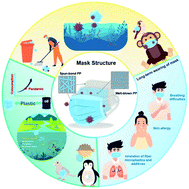
Environ. Sci.: Processes Impacts, 2022,24, 649-674
https://doi.org/10.1039/D1EM00509J
Battling the known unknowns: a synoptic review of aquatic plastics research from Australia, the United Kingdom and China
A synoptic review of aquatic plastics research from Australia, the United Kingdom and China is presented, highlighting (a) key research and management challenges, and (b) a need to converge on standardised methods and bioindicator species to make global comparisons more reliable.
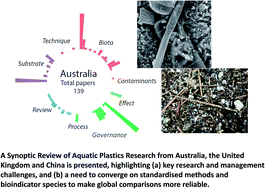
Environ. Sci.: Processes Impacts, 2021,23, 1663-1680
https://doi.org/10.1039/D1EM00175B
Macroplastics in rivers: present knowledge, issues and challenges
The contextualization of macroplastics in a budget framework can help to improve our understanding of the physical processes determining macroplastic behaviour and impacts in rivers. Hence, better management practices can be adopted.
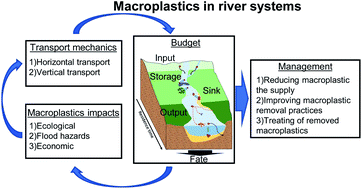
Environ. Sci.: Processes Impacts, 2021,23, 535-552
https://doi.org/10.1039/D0EM00517G
The fate of plastic in the ocean environment – a minireview
The fate of plastic in the ocean is influenced by physical, chemical and biological stressors. These cause fragemntation and the formation of micro and nanoplastics but also degradation of plastics.
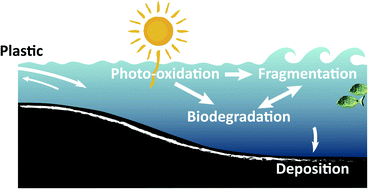
Environ. Sci.: Processes Impacts, 2021,23, 198-212
https://doi.org/10.1039/D0EM00446D
Metals in microplastics: determining which are additive, adsorbed, and bioavailable
Microplastics from the North Atlantic Gyre deposited on Guadeloupe beaches were sampled and characterized.
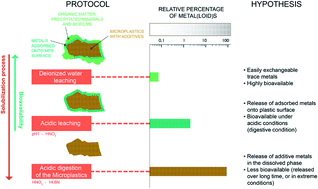
Environ. Sci.: Processes Impacts, 2021,23, 553-558
https://doi.org/10.1039/D1EM00017A
Fluorogenic hyaluronan nanogels for detection of micro- and nanoplastics in water
Nano- and microplastics are polluting the environment and their detection remains elusive. A fluorogenic hyaluronan shows high affinity toward their surfaces, turning brightly emissive, and its lifetime allows discrimination of plastics in nature.
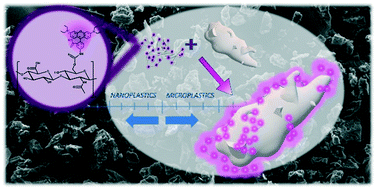
Environ. Sci.: Nano, 2022,9, 582-588
https://doi.org/10.1039/D1EN00684C
Micro- and nanoplastic transfer in freezing saltwater: implications for their fate in polar waters
While microplastics are trapped in saline ice, nanoplastics are expulsed along with salts. Natural organic matter, such as alginate, stabilizes nanoplastics against aggregation during freezing.
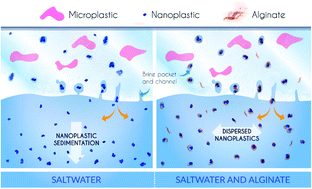
Environ. Sci.: Processes Impacts, 2021,23, 1759-1770
https://doi.org/10.1039/D1EM00280E
Adsorption of progesterone onto microplastics and its desorption in simulated gastric and intestinal fluids
Microplastics interact with molecules present in the environment. In this study, progesterone sorption on microplastics and its desorption were investigated, and it was found that desorption was promoted in gastrointestinal fluids.
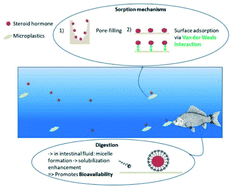
Environ. Sci.: Processes Impacts, 2021,23, 1566-1577
https://doi.org/10.1039/D1EM00226K
Functionalized polystyrene nanoplastic-induced energy homeostasis imbalance and the immunomodulation dysfunction of marine clams (Meretrix meretrix) at environmentally relevant concentrations
Functionalized polystyrene nanoplastics inhibit the growth of marine clams (Meretrix meretrix) through energy homeostasis imbalance and immunomodulation dysfunction at environmentally relevant concentrations.
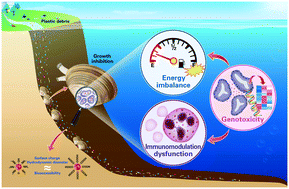
Environ. Sci.: Nano, 2021,8, 2030-2048
https://doi.org/10.1039/D1EN00212K
The sorption behaviour of amine micropollutants on polyethylene microplastics – impact of aging and interactions with green seaweed
Microplastics are ubiquitous in the environment.
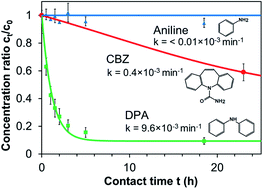
Environ. Sci.: Processes Impacts, 2020,22, 1678-1687
https://doi.org/10.1039/D0EM00119H
Potentiation of polycyclic aromatic hydrocarbon uptake in zebrafish embryos by nanoplastics
The presence of microplastics in the environment and their potential effects on the health of organisms are a subject of great concern.
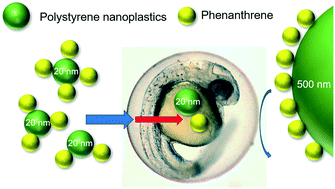
Environ. Sci.: Nano, 2020,7, 1730-1741
https://doi.org/10.1039/D0EN00163E
About this collection
Human activities have caused an increase in plastic and marine pollution, leading to the collapse of marine ecosystems amid acidification and ocean warming. This collection showcases some of the latest research in Royal Society of Chemistry journals on marine litter and pollution. We hope you enjoy reading the papers in this collection and we welcome you to submit your next paper on this theme to our journals.